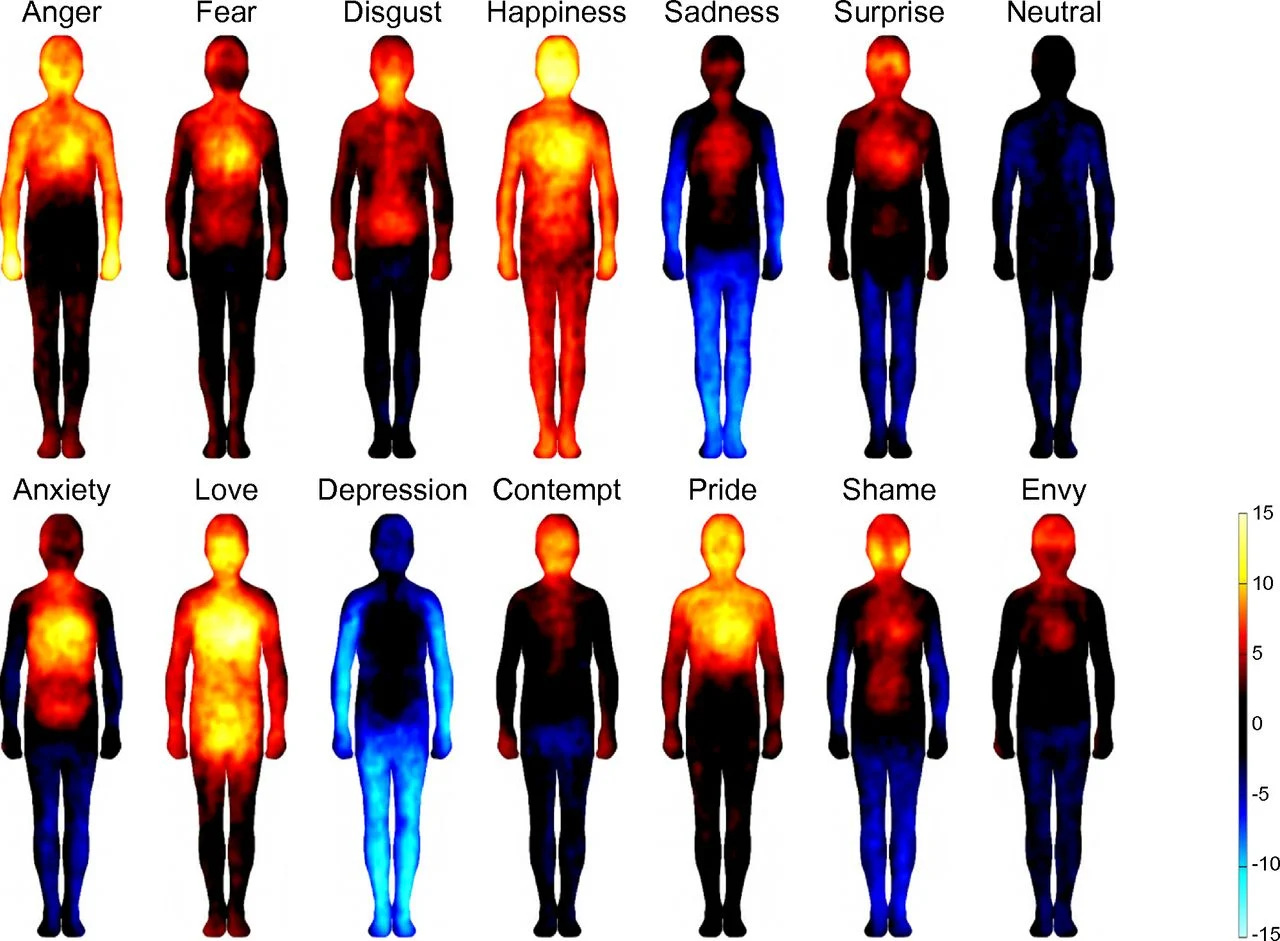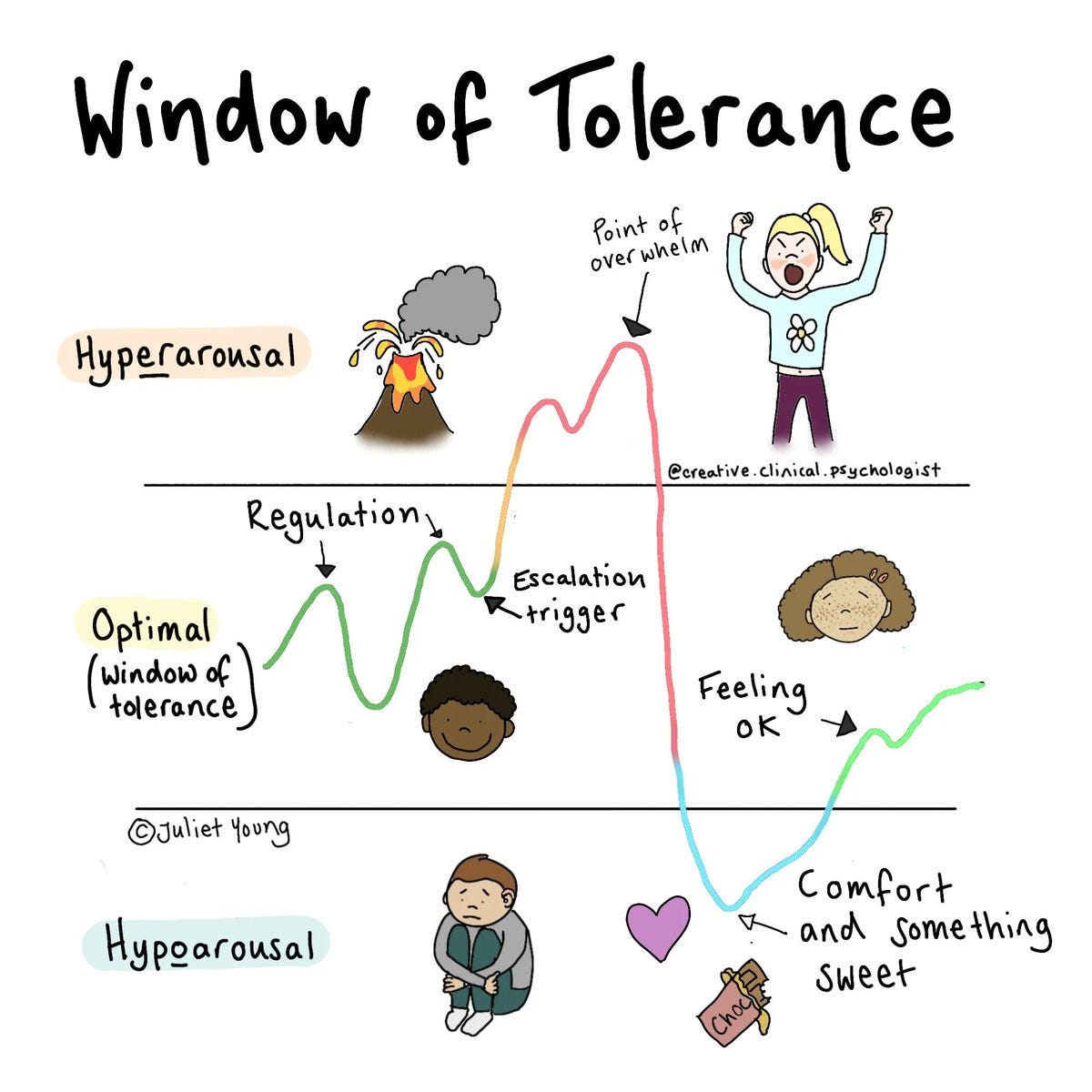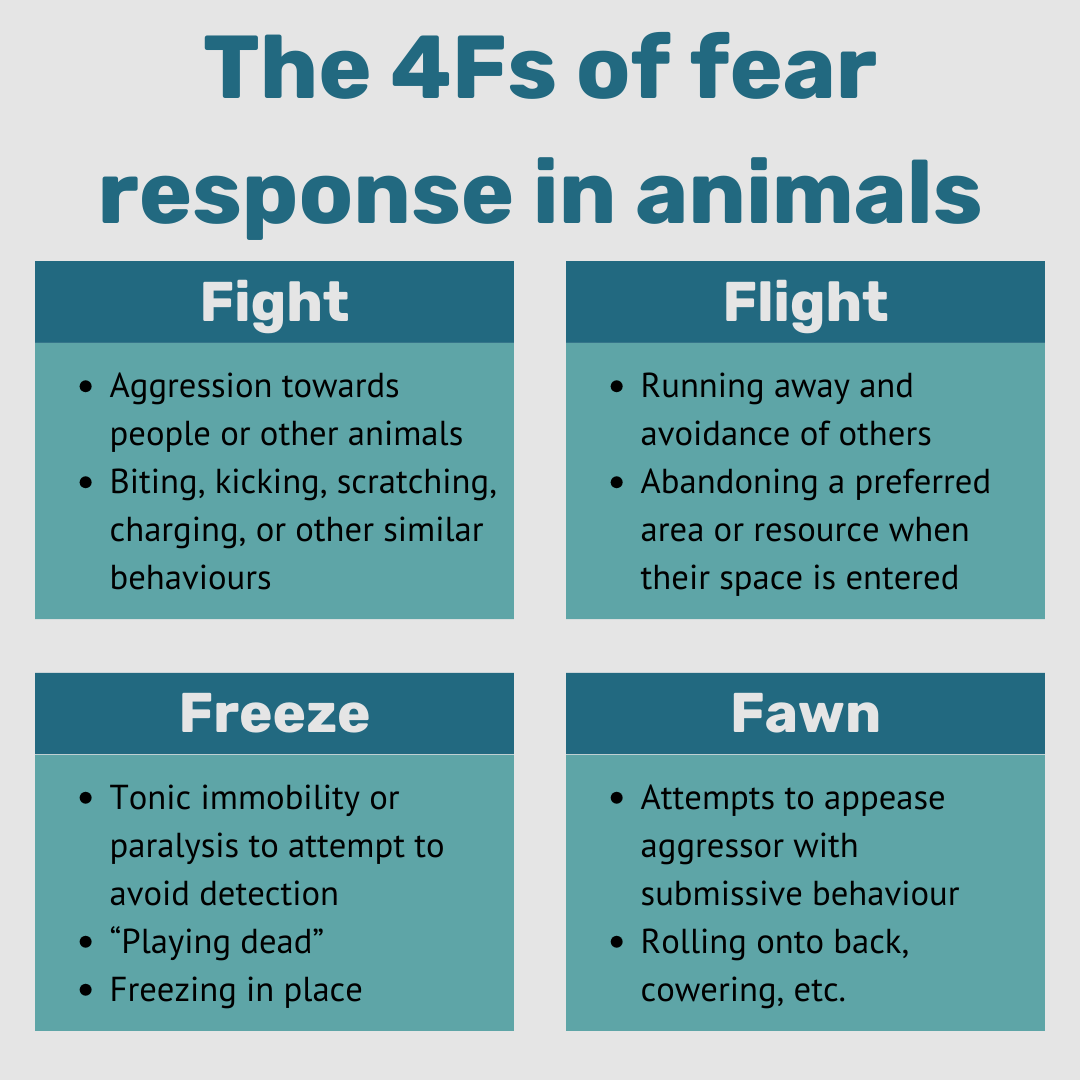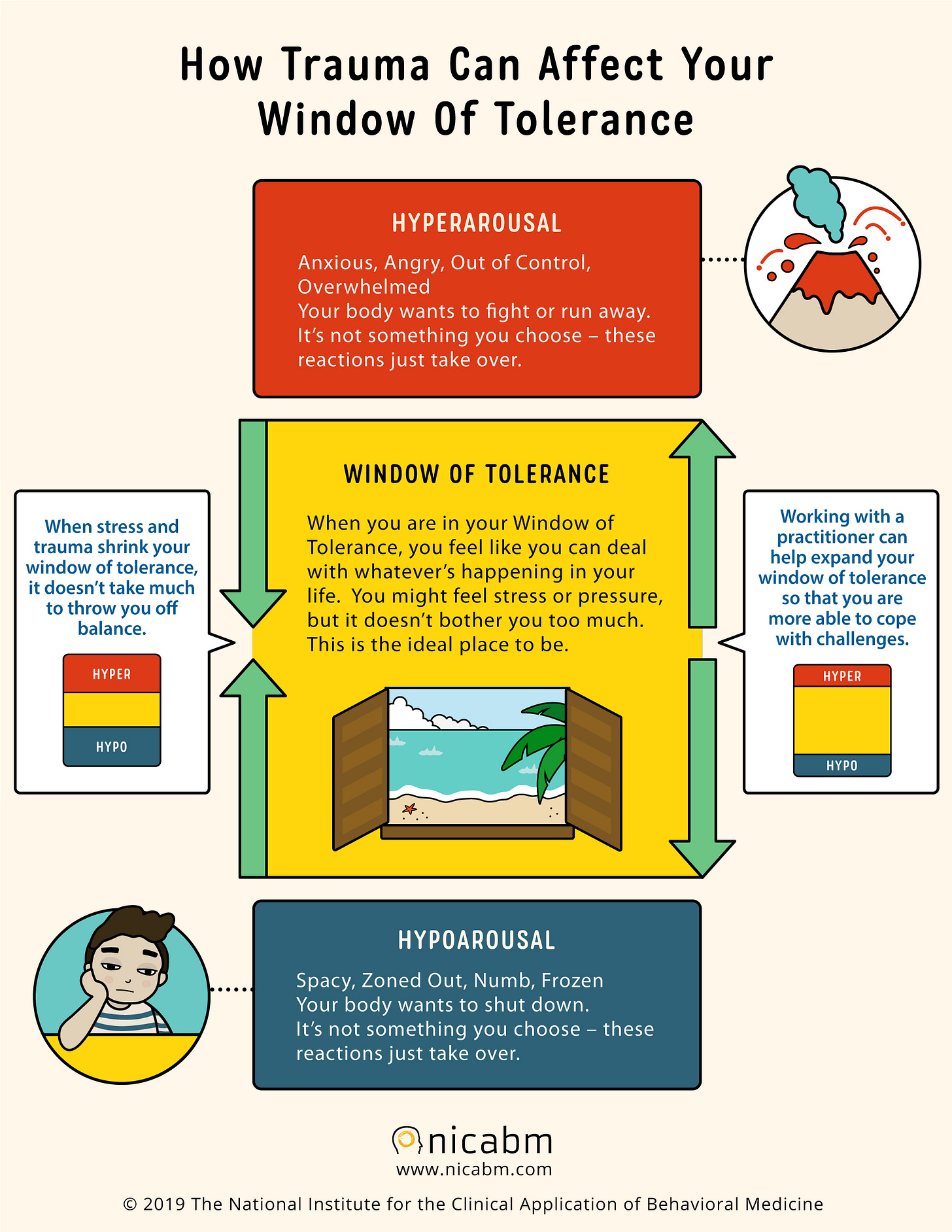It's mid-October, and the landscape is adorned with hues of orange as leaves cascade from the trees, crunching underfoot as you walk. The crisp chill in the air sets the perfect ambiance to watch a horror movie. Even if you're not typically a fan of the genre, something about tonight beckons you. The internet is abuzz with chatter about a recently released streaming horror film, and everyone you know is talking about it. So, why not?
You slip into your comfiest clothes, brew your favorite hot drink, and fill a bowl with popcorn. Nestled on the couch with a cozy blanket pulled up to your chin, you hit play. Within minutes, your heart rate quickens, your muscles tense, and you find yourself gripping the bowl of popcorn tightly. You may not be ready for such an activation. Wait! You can learn to understand the complex workings of your nervous system and implement tools that settle your nervous system when it’s been activated just by watching horror movies.
Cinematic Sentiments: We feel what we watch
Whether we're indulging in comedy, drama, or horror, our emotional responses are often triggered by what we watch. Movies and television shows offer a structured platform to experience and process feelings. Some of us watch sad videos to cry, some of us watch comedies to laugh, and some of us watch dramas and horror films to access a symphony of emotions, such as shock, awe, disgust, anger, happiness, love, and all the feels.
According to the article "Neurocinematics: How Films Influence Brains & Emotions," narrative storytelling in movies frequently prompts us to connect with characters, immersing us in their emotional journeys. We experience joy, sorrow, fear, and rage alongside these characters thanks to our mirror neuron system, which enables us to empathize with their emotional states.
Another study found movies affect mood; depending on the content, what we watch can negatively or positively affect emotional states. According to Raja Selvam, "The body can be likened to an orchestra with a large number of instruments (or body systems) that can play a wide variety of melodies (or emotions) by creating complex arrays (patterns) of physiological changes." Thus, this demonstrates the complex interaction between our bodies and the stimulus we are taking in. The environment influences the song of the instruments.

We feel what we watch, and this interacts with our nervous system. Are we safe? Are we in danger? Do we need to respond?
Snuggle in and get your popcorn ready; we will explore the interactions of emotions, your nervous system, and horror movies, arming you with the tools to navigate this terrain.
So, how can horror movies help us navigate our nervous systems?
It might seem strange and counterproductive, but delving into the horror genre can serve as a valuable means of comprehending and managing our nervous systems. It offers an avenue to explore our nervous system's complexities and acquire effective regulation techniques.
On the screen before you, the protagonist hears a sound in the basement. The scene switches to the killer hiding among various boxes and furniture discarded in the basement. Your eyes are wide, your heart races and your hands sweat as they grip the blanket. Your nervous system responds to what you are watching.

Despite harboring caution towards the unfamiliar, humans possess a robust curiosity and intrigue for the extraordinary. Our brains' makeup and the desire to experience fuel our attraction to the unknown, drawing us toward it.
We actively pursue exposure to violence in the news and online media and are equally attracted to thrillers and horror movies. A desire for sensation fuels this inclination, as the chilling and macabre elements evoke thrilling sensations. These sensations may be perceived as enjoyable when encountered within a secure environment.
The negative emotions evoked while viewing horror movies forecast the level of enjoyment experienced by the viewers.
Why? Fear and excitement are arousal states and share a significant neurobiological foundation. Our arousal states represent a physiological activation or responsiveness level affected by sensory stimuli and emotions. One of the critical similarities is the hypothalamus-driven regulation of the physiological stress response, which results in blending these two emotions, where fear may manifest as excitement. The intersection of fear and excitement can be confusing, and we often do not know what to do with the blending of arousal states. Our arousal states are functions of our nervous systems.
Clutching the blanket, your elevated heart rate sings with fear and excitement as you notice your blood rushing through your veins. Perhaps a smile turns up the corners of your mouth, even as you shrink into your seat, clutching the blanket still nestled under your chin, as you watch the protagonist venture into the basement with only a flashlight.
As a Somatic Experiencing Practitioner (SEP), I am ready to guide individuals in learning, navigating, and healing their nervous systems. One way we can work with the confusion and experiencing two often conflicting arousal states is through horror. Horror makes us curious about what we do not know; it is unfamiliar and presents exciting and fear-inducing scenarios.
What is Somatic Experiencing?
Somatic Experiencing (SE) seeks to alleviate the symptoms of stress, shock, and trauma that can become lodged in our bodies. When we find ourselves trapped in cycles of fight, flight, or freeze responses, SE assists in releasing these patterns, facilitating recovery, and fostering resilience (Somatic Experiencing Trauma Institute, n.d.). SE has been employed in clinical settings for over four decades, rooted in a diverse blend of disciplines, including physiology, psychology, ethology, biology, neuroscience, indigenous healing traditions, and medical biophysics (Somatic Experiencing Trauma Institute, n.d.). Through this work, we gain a deeper understanding of our nervous system's activations and cultivate the capacity to expand its resilience in managing discomfort. {end callout)
Horror provides us with a container to experience excitement and fear. When we watch horror in a controlled environment, we can apply tools to enhance our awareness of our nervous systems and better understand and regulate them. Whether you're seasoned or just starting, I'll introduce exercises to kickstart or improve your practice.
These exercises foster self-awareness and personal growth, serving as engaging tools for reflection and insight. However, it's essential to recognize that they do not replace therapy. While they can be beneficial, they need more comprehensive support and guidance from a qualified therapist. If you're facing significant emotional distress or mental health challenges, it's crucial to prioritize your well-being by seeking professional assistance. Moreover, pause and seek support immediately if you encounter a traumatic activation during these exercises. Remember, your mental health comes first, and reaching out to a qualified mental health professional for guidance is highly recommended.

We will use horror movies to process emotions, primarily how they manifest and influence your nervous system. The exercises below can be added to your mental health tool kit (if you need ideas on building yours, click here).
The Exercises
Exercise 1: Settle and Orient
You can do this exercise on its own and as often as needed. I recommend the people I work with do this exercise throughout the day, especially during transitions or when they notice feeling unsettled or activated. I recommend that you make this exercise part of your daily routine, not only when you are watching a scary movie or something that activates your nervous system.
We will start with an exercise to orient and settle into your space. Orienting is a beautiful way to begin understanding and learning about your nervous system and expand your window of tolerance. Your window of tolerance is your ability to deal with stress. The term window of tolerance refers to the range of arousal levels within which an individual can function optimally.
The exercise:
1. Take a moment to notice your weight in your seat. You might even wiggle slightly and notice the sensations as you adjust your body to feel supported in your seat.
2. Slowly look around your space: in front of you, above you, below you, and behind you. When looking behind, move from your hips; this tells your nervous system you can access mobility and are not trapped. If you look around quickly, your nervous system will think there is a possible danger nearby, and it will be harder to relax and calm it.
3. Notice all your exits (windows and doors). By telling your nervous system that you can leave if necessary, you reinforce that you are not trapped.4. Allow your eyes to gaze at the horizon or find something that draws your attention—curiosity and a wide field of vision tell our nervous system that we are safer. I use the term safer as safe can be an activating term. When we have experienced trauma, safe becomes a relative term. We feel and experience safe on a spectrum. Working on a spectrum of safer supports us in understanding our body's activations and spaces in which we do not feel activated or less activated.
4. Time to move! I call this part of the exercise the joint dance with my clients. You can do this sitting or standing. Move your joints: neck, shoulders, elbows, wrists, hips, knees, and ankles. You might sway or rock, allow your body to move naturally. You might shake your legs and allow your feet to run. When we feel unsafe, our joints tense to prepare us to fight, fight, or freeze. Providing is a way of intentionally countering this response.
5. Raise your hands above your head and move them like you are tracing a rainbow; if you'd like, stand up and take a few steps from side to side, front to back. If you are sitting, stretch your legs in front of you and sit up tall. Again, taking up space tells our nervous system we are not under threat. When we are under threat, we shrink to protect ourselves.
6. Take a moment to notice how you feel. Journal if you'd like. Keeping a record can also help us recognize when we are activated and feel settled.
7. Repeat as necessary. Especially when you notice you are activated. Each time you repeat this exercise, you expand your window of tolerance and your ability to sit with difficult emotions.

The Why:
Deep within every creature's brain lies the primal core known as the reptilian brain; it is the seat of our instincts. Biologically essential to all living beings, including humans, the reptilian brain harbors instinctual blueprints for behaviors crucial to species survival, such as self-preservation and reproduction. It also governs involuntary bodily functions vital for sustaining life.
"Trauma can also be the body's response to anything unfamiliar or anything it does not understand, even if it is not cognitively dangerous. The body does not reason; it's hardwired to protect itself and react to sensation and movement."
Our survival instinct, or reptilian brain, takes control during a life-threatening event. Its sole objective is our survival. It doesn't concern itself with the how; its priority is ensuring we stay alive. When triggered, the survival brain operates independently of our rational faculties. Why? Engaging the rational brain could jeopardize bodily survival.
Consider this scenario: you encounter a man with a machete on your hike. Instantly, your survival brain kicks into action, prioritizing your survival. There's no room for the rational brain to intervene in such moments. If it were allowed to engage, it might analyze the situation—Is it truly a man with a machete? What are the available options: fight, flight? Otherwise, it could delay the body's automatic response to safeguard itself.
Exercise 2: Feeling good
This exercise can be done as often as needed, in conjunction with exercise 1 or on its own, when you notice you are not feeling your best.
This exercise supports you in recognizing and reminding yourself to notice when your body feels good. It can also assist you when you find yourself focusing on uncomfortable sensations or experiencing dysregulation.
The Exercise:
How does your body feel when experiencing good emotions like joy, happiness, and even laughter? You can watch something funny that evokes positive feelings or recall a memory that made you happy or joyous. Our bodies can learn to access these emotions at any time, which also helps to expand our window of tolerance.
1. Before doing this exercise, you start with exercise 1.
2. Watch the funny/feel-good video or recall a happy memory. Take a moment to hold the image in your mind. What do you notice in your body? Where do you feel good? Can you describe those feelings? Do you feel open, expansive, light, bubbly, warm?
3. Take a moment to radiate this sensation throughout your body. You can do this by focusing on the feel-good sensation and sending it through your body. Imagine the feel-good space is like a lava lamp, hourglass, or raindrops, and visualize it dripping to other parts of your body. Notice how far you can spread the sensation. Does it stop in certain places? Does it stay in one place? Which direction can you move the sensation? It's okay if you can't move the feel-good sensations; if you can't, focus on where you notice the pleasant sensations. If you'd like, take a moment to journal your experience.
The Why:
This exercise serves as a baseline or activity to support you in identifying where you feel good emotions and sensations and learning how to direct your attention to those spaces. According to the Mayo Clinic, Finding contentment and joy can have a beneficial impact on both physical and mental health, as well as overall well-being. In addition, positive emotions drive personal growth, shaping individuals' perspectives and enhancing their ability to thrive. Joyful and engaging experiences kickstart exploration, learning, and connection, leading to the acquisition of new resources that enrich life and offer opportunities for further growth.
Dysregulation occurs when we become trapped in a highly aroused state and, instead of quickly settling into a more balanced and centered state, our nervous system struggles to revert to its former equilibrium, causing us to lose our sense of fluidity. Our bodily sensations dictate our emotional experiences in our everyday lives. When our nervous system is overwhelmed, our ability to experience joy and presence becomes restricted. When we do this exercise, we support our nervous system in moving closer, if not returning to a more balanced and centered state.
Exercise 3: Horror movie activation
This exercise aims to help you understand your nervous system and window of tolerance when you are activated. It should be done ONLY after completing exercises 1 and 2.
The exercise:
1. Starting with lighter movies. Choose from Ghostbusters (1980), ParaNorman (2012), or Goosebumps (2015). If you don't like these options, start with any PG-rated horror movie. You can work your way up to scarier movies as you increase your window of tolerance.
2. Pause the movie whenever you feel unease, tension, discomfort, or anything else that is different from your settled or feel-good space. Where do you notice it, and what do you notice? Is your jaw clenched, your shoulders lifted? Are your hands in a fist or gripping something? Are you holding your breath? Are you fidgeting or moving your legs?
3. Take a moment to orient and settle yourself (repeat exercise 1 if necessary). Notice the difference after you orient.
You can journal as you do this or, if you prefer, be in the experience.
The Why:
Doing this exercise can provide valuable insight into our window of tolerance and what activates us. We can even share this with our therapists to expand the work from the exercise. When we expand our window of tolerance, we have a greater capacity to deal with life stressors.
Exercise 4: Soothing your primal brain
This exercise lets you tap into your primal brain and settle your nervous system when activated.
The Exercise:
Before you begin, grab a stuffed animal, soft blanket, or pillow to hold in front of your chest. When you notice you are feeling activated, squeeze the soft item you are holding, and be sure to squeeze not only with your arms but also with your hands. Reaching for our caregivers and squeezing them for comfort has been a primal movement since infancy.
The Why:
More than six decades ago, Harlow (1958) illustrated through his research on infant monkeys using surrogate mothers made of wire and cloth, preferring physical contact over proximity to food sources. Research on orphaned human infants brought up in deprived environments indicates that the absence of nurturing physical contact with caregivers has profound repercussions on infant development. From a physiological standpoint, engaging in physical contact with infants, especially frontal contact, triggers the release of oxytocin, a hormone linked to nurturing behaviors and feelings of well-being. When we squeeze something soft close to us, we simulate the contact and comfort we innately seek as infants.
Exercise 5: What would you do?
Horror movies often have characters who make bad decisions, like running upstairs. We watch them in dismay as they make poor choices regarding their safety. We now understand why someone would run up the stairs and not out the door; that doesn't change the fact that we know their fate before they do. Our survival brain kicks in as we watch powerlessly; we want them to live. This exercise puts you in the director's seat; you don't have to follow the misguided person up the stairs, and you get to decide what you would do, like the choose your adventure books. You get to yell, "Cut," and reshoot the scene here.
The Exercise:
1. When you observe a character making a choice you disagree with, like running up the stairs, pause the movie and allow yourself to orient.
2. Then, say what you would do. Take a moment to imagine yourself running outside, getting help, and feeling safer. Allow your feet to move by running in place, or you may need to stand up, walk around, get up, and move, punch, kick, or yell. You allow your nervous system to do what it needs to do in the situation. It moves and settles the activation.
3. Orient, do the joint dance, wiggle, and take up space before starting the movie again.

Final Thoughts
When we comprehend the workings of our nervous system, we can broaden our window of tolerance and develop the ability to manage life stressors and traumatic triggers, even when faced with the world's horrors. It enables us to provide better support, both for ourselves and others, during activation times. Using techniques like orienting helps us stay grounded and in the moment, while positive emotions boost us and help us deal with tough times. Who knew that watching horror movies could be a way to explore our feelings in a safe and controlled environment?
The protagonist has defeated the killer. Your body relaxes, and you push the blanket off, smiling; a wave of relief sweeps over you. The movie is over, and you feel secure in your home, ready for your next adventure.
What movie did you watch?
How were the exercises?
Practitioners who have influenced my work:
Upcoming:
What is Trauma
Fading Memories, Enduring Bonds: Understanding Dementia's Impact on Families
Works cited:
Bigelow, A. E., & Rankin Williams, L. (2020). To have and to hold: Effects of physical contact on infants and their caregivers. Infant Behavior and Development, 61, 101494. doi: 10.1016/j.infbeh.2020.101494
Cohn, M. A., Fredrickson, B. L., Brown, S. L., Mikels, J. A., & Conway, A. M. (2009). Happiness Unpacked: Positive Emotions Increase Life Satisfaction by Building Resilience. Emotion, 9(3), 361–368. doi: 10.1037/a0015952
Fernández-Aguilar, L., Navarro-Bravo, B., Ricarte, J., Ros, L., & Latorre, J. M. (2019, November 21). How effective are films in inducing positive and negative emotional states? A meta-analysis. PloS one. https://www.ncbi.nlm.nih.gov/pmc/articles/PMC6872151/
Levine, Peter A.; Frederick, Ann. Waking the Tiger: Healing Trauma (p. 87). North Atlantic Books. Kindle Edition.
NICABM. (n.d.). Trauma: How to Help Your Clients Understand Their Window of Tolerance. Retrieved from https://www.nicabm.com/trauma-how-to-help-your-clients-understand-their-window-of-tolerance/
Mayo Clinic Health System. (n.d.). Tips for embracing joy in daily life. Retrieved from https://www.mayoclinichealthsystem.org/hometown-health/speaking-of-health/tips-for-embracing-joy-in-daily-life#:~:text=Joy%20is%20a%20powerful%20emotion,health%20and%20overall%20well%2Dbeing.
Menakem, Resmaa. My Grandmother's Hands: Racialized Trauma and the Pathway to Mending Our Hearts and Bodies. Central Recovery Press, 2017.
Mirage News. (2023, June 16). Neurocinematics: How films influence brains & emotions. Mirage News. https://www.miragenews.com/neurocinematics-how-films-influence-brains-1028661/#:~:text=Moreover%2C%20narrative%20storytelling%20in%20films,emp
Mi-Psych. "Understanding Your Window of Tolerance." Retrieved from: https://mi-psych.com.au/understanding-your-window-of-tolerance/#:~:text=%E2%80%9CWindow%20of%20Tolerance%E2%80%9D%20is%20a%20term%20used%20to%20describe%20the,able%20to%20function%20most%20effectively.
Ocampo, S. (2023, February 6). Alive in the Body: Healing Trauma and Overwhelm with Somatic Experiencing. Retrieved from https://traumahealing.org/alive-in-the-body-healing-trauma-and-overwhelm-with-somatic-experiencing/#:~:text=In%20the%20language%20of%20Somatic,joy%20and%20presence%20becomes%20limited.athize%20with%20their%20emotional%20states.
Selvam, Raja. The Practice of Embodying Emotions (p. 100). North Atlantic Books. Kindle Edition.
Somatic Experiencing Trauma Institute. "Somatic Experiencing 101." Somatic Experiencing Trauma Institute, [URL]. Accessed [March 29, 2024]















I love this, Margaret. So many good tips. I've never thought these could be done as I always thought that there were two types of people: those who can't stand horror and those who love it.
Thank you! Excited to hear if you try it and it doesn't have to be horror, anything that you watch that you notice activated your nervous system.